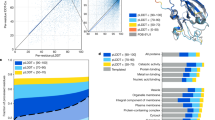Abstract
The provably efficient randomized approximation scheme which evaluates the partition function for the wide class of lattice models of protein prediction is presented. We propose to apply the idea of self-testing algorithms introduced recently in [8]. We consider the protein folding process which is simplified to a self-avoiding walk on a lattice. The power of a simplified approach is in its ability to search the conformation space, to train the search parameters and to test basic assumptions about the nature of the protein folding process. Our main theoretical results are formulated in the general setting, i.e. we do not assume any specific lattice model. For the simulation study we have chosen the HP model on the FCC lattice.
Research supported by Polish Research Council KBN grant 4 T11C 044 25.
Preview
Unable to display preview. Download preview PDF.
Similar content being viewed by others
References
Dill, K.A., Bromerg, S., Yue, K., Fiebig, K.M., Yee, P.D., Thomas, P.D., Chan, H.S.: Principles of protein folding – A perspective from simple exact models. Protein Science 4, 561–602 (1995)
Jerrum, M.R., Sinclair, A.J.: Approximating the permanent. SIAM Journal on Computing 18, 1149–1178 (1989)
Madras, N., Slade, G.: The Self-Avoiding Walk, Birkhäuser, Boston (1993)
Nayak, A., Sinclair, A., Zwick, U.: Spatial Codes and the Hardness of String Folding. Journal of Computational Biology 6(1), 13–36 (1999)
Niemiro, W., Pokarowski, P.: Faster MCMC Estimation Along One Walk (2001) (Preprint)
Pokarowski, P., Koliński, A., Skolnik, J.: A minimal physically realistic protein-like lattice model: Designing an enargy landscape that ensures all-or-one folding to a unique native state. Biophysical Journal (2003) (in press)
Randall, D.: Counting in lattices: combinatorial problems from statistical mechanics. PhD Thesis, UC Berkeley (1995)
Randall, D., Sinclair, A.J.: Self-Testing Algorithms for Self-Avoiding Walks. Journal of Mathematical Physics 41, 1570–1584 (2000)
Schuster, P., Stadler, P.F.: Discrete Models of Biopolymers (1999) (TBI Preprint)
Sinclair, A.J.: Algorithms for random generation and counting: a Markov chain approach, Birkhäuser, Boston (1992)
Will, S.: Constraint-based hydrophobic core construction for protein structure prediction in the face-centered-cubic lattice. In: Proc. Pacific Symposium on Biocomputing (2002)
Author information
Authors and Affiliations
Editor information
Editors and Affiliations
Rights and permissions
Copyright information
© 2005 Springer-Verlag Berlin Heidelberg
About this paper
Cite this paper
Gambin, A., Wójtowicz, D. (2005). Almost FPRAS for Lattice Models of Protein Folding. In: Nikoletseas, S.E. (eds) Experimental and Efficient Algorithms. WEA 2005. Lecture Notes in Computer Science, vol 3503. Springer, Berlin, Heidelberg. https://doi.org/10.1007/11427186_46
Download citation
DOI: https://doi.org/10.1007/11427186_46
Publisher Name: Springer, Berlin, Heidelberg
Print ISBN: 978-3-540-25920-6
Online ISBN: 978-3-540-32078-4
eBook Packages: Computer ScienceComputer Science (R0)




